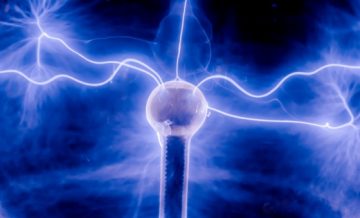

The table shows electrical conductivity values for the elements sodium to argon, relative to aluminium (which I have set at 1).
| Element | Symbol | Atomic number | Electrical conductivity |
|---|---|---|---|
| Sodium | Na | 11 | 0.55 |
| Magnesium | Mg | 12 | 0.61 |
| Aluminium | Al | 13 | 1 |
| Silicon | Si | 14 | 0.10 |
| Phosphorus | P | 15 | 0 |
| Sulfur | S | 16 | 0 |
| Chlorine | Cl | 17 | 0 |
| Argon | Ar | 18 | 0 |
Substances conduct electricity if they contain charged particles that can move from place to place when a potential difference is applied.
The table below gives some information about different substances.
| Type of substance | Notes |
|---|---|
| Metal | Conduct when solid or liquid |
| Covalent substance | Do not conduct (graphite is an exception) |
| Ionic compound | Conduct when dissolved or when liquid |
The graph shows how electrical conductivity varies across period 3.
There is a lot going on in this graph, so it is often easier to divide it into three sections. The table below gives a brief summary of these sections.
| Element(s) | Type of element | Type of structure | Description |
|---|---|---|---|
| Na, Mg, Al | Metal | Metallic | Conductivity increases from Na to Al |
| Si | Metalloid | Giant covalent | Conductivity much less than Na, Mg and Al |
| P, S, Cl, Ar | Non-metal | Simple molecular (Ar is monatomic) | Do not conduct electricity |
When you click on the download symbol, you will be able to download the graph as an image file or pdf file, save its data, annotate it, and print it.
Sodium, magnesium and aluminium are all metals. They have metallic bonding, in which the nuclei of metal atoms are attracted to delocalised electrons.
Going from sodium to aluminium:
Metallic bonding is often described as the attraction between positive metal ions and delocalised electrons. This is incorrect because metals still consist of atoms, but the outer electrons are delocalised and are free to move through the structure.
Silicon has a giant covalent structure. It is a semiconductor, so it is not a good conductor or a good insulator.
The giant lattice structure of silicon is similar to that of diamond. Each silicon atom is covalently bonded to four other silicon atoms in a tetrahedral arrangement.
The remaining elements in period 3 do not conduct electricity. They have no free electrons that can move around and carry charge from place to place.
The atoms in molecules of phosphorus, sulfur or chlorine are attracted to each other by covalent bonds.
![]()
This website uses cookies to improve your experience. I'll assume you're okay with this, but you can opt-out if you wish. Read More
Cookies are small text files that can be used by websites to make a user's experience more efficient. The law states that we can store cookies on your device if they are strictly necessary for the operation of this site. For all other types of cookies we need your permission. This site uses different types of cookies. Some cookies are placed by third party services that appear on our pages.
Always ActiveNecessary cookies help make a website usable by enabling basic functions like page navigation and access to secure areas of the website. The website cannot function properly without these cookies.
| Name | Domain | Purpose | Expiry | Type |
|---|---|---|---|---|
| JSESSIONID | ichemlabs.cloud.chemdoodle.com | A generic technical cookie used for storing user session identifier in web applications. | 54 years | HTTP |
| YSC | youtube.com | YouTube session cookie. | 54 years | HTTP |
Marketing cookies are used to track visitors across websites. The intention is to display ads that are relevant and engaging for the individual user and thereby more valuable for publishers and third party advertisers.
| Name | Domain | Purpose | Expiry | Type |
|---|---|---|---|---|
| VISITOR_INFO1_LIVE | youtube.com | YouTube cookie. | 6 months | HTTP |
Analytics cookies help website owners to understand how visitors interact with websites by collecting and reporting information anonymously.
PreferencesPreference cookies enable a website to remember information that changes the way the website behaves or looks, like your preferred language or the region that you are in.
UnclassifiedUnclassified cookies are cookies that we are in the process of classifying, together with the providers of individual cookies.